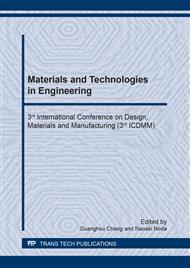[1]
Barnes, T. A., Pashby, I. R., Joining techniques for aluminium spaceframes used in automobiles: Part II - adhesive bonding and mechanical fasteners, Journal of Materials Processing Technology, Vol. 99 (2000), pp.72-79.
DOI: 10.1016/s0924-0136(99)00361-1
Google Scholar
[2]
Higgins, A., Adhesive bonding of aircraft structures, International Journal of Adhesion and Adhesives, Vol. 20, No. 5 (2000), pp.367-376.
DOI: 10.1016/s0143-7496(00)00006-3
Google Scholar
[3]
Petrie, E. M., Adhesives for the assembly of aircraft structures and components: Decades of performance improvement, with the new applications of the horizon, Metal Finishing, Vol. 106, No. 2 (2008), pp.26-31.
DOI: 10.1016/s0026-0576(08)80035-9
Google Scholar
[4]
Akisanya, A. R., Meng, C. S., Initiation of fracture at the interface corner of bi-material joints, Journal of the Mechanics and Physics of Solids, Vol. 51 (2003), pp.27-46.
DOI: 10.1016/s0022-5096(02)00076-5
Google Scholar
[5]
Hattori, T., A stress-singularity-parameter approach for evaluating adhesive strength of single lap joints, Transactions of the Japan Society of Mechanical Engineers, Series A, Vol. 56,No. 523 (1990), pp.618-623 (in Japanese).
DOI: 10.1299/kikaia.56.618
Google Scholar
[6]
Mintzas A. and Nowell, D., Validation of an Hcr - based fracture initiation criterion for adhesively, Engineering Fracture Mechanics, Vol. 80 (2012), pp.13-27.
DOI: 10.1016/j.engfracmech.2011.09.020
Google Scholar
[7]
Miyazaki, T., Noda, N. -A., Wang, Z. and Sano, Y., Analysis of intensity of singular stress field for bonded cylinder in comparison with bonded plate, Transactions of the Japan Society of Mechanical Engineers, Vol. 81, No. 829 (2015).
DOI: 10.1016/j.ijadhadh.2017.03.019
Google Scholar
[8]
Noda, N. -A., Miyazaki, T., Uchikoba, T., Li, R., Sano, Y. and Takase, Y., Convenient debonding strength evaluation based on the intensity of singular stress for adhesive joints, Journal of the Japan Institute of Electronics Packaging, Vol. 17, No. 2 (2014).
DOI: 10.5104/jiep.17.132
Google Scholar
[9]
Miyazaki, T., Noda, N. -A., Analysis of Intensity of Singular Stress Field for Bonded Cylinder under Bending Load, International Journal of Fracture, Fatigue and Wear, Vol. 4 (2016), p.166 – 171.
Google Scholar
[10]
Bogy, D. B., Edge-bonded dissimilar orthogonal elastic wedges under normal and shear loading, Transaction of the ASME, Journal of Applied Mechanics, Vol. 35 (1968), pp.460-466.
DOI: 10.1115/1.3601236
Google Scholar
[11]
Bogy, D. B., Two edge-bonded elastic wedges of different and wedge angles under surface tractions, Transaction of the ASME, Journal of Applied Mechanics, Vol. 38 (1971), pp.377-386.
DOI: 10.1115/1.3408786
Google Scholar
[12]
Noda, N. -A., Shirao, R., Li, J. and Sugimoto, J., Intensity of singular stress at the end of a fiber under pull-out force, Transactions of the Japan Society of Mechanical Engineers, Series A, Vol. 72, No. 721, (2006), pp.1397-1404 (in Japanese).
DOI: 10.1299/kikaia.72.1397
Google Scholar
[13]
Dundurs, J., Discussion of edge-bonded dissimilar orthotropic elastic wedges under normal and shear loading, Transaction of the ASME, Journal of Applied Mechanics, Vol. 36 (1969), pp.650-652.
DOI: 10.1115/1.3564739
Google Scholar


